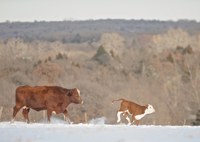
Agricultural News
Cattle Producers Encouraged to Remember Livestock Drinking Water Needs During Winter Weather
Thu, 15 Dec 2016 10:02:54 CST
 Chilly and sometimes freezing temperatures are making their wintertime appearance in the Southern Plains states, and that means livestock producers need to be paying extra attention to the drinking water needs of their animals.
Chilly and sometimes freezing temperatures are making their wintertime appearance in the Southern Plains states, and that means livestock producers need to be paying extra attention to the drinking water needs of their animals.
Winter weather can be picturesque but with it comes the need to ensure animal drinking water needs are met.
"No matter what type of livestock you raise, remember the days when you most want to stay by the fire are the days it pays to pay closer attention to water management," said Robert Bourne, Bryan County Extension director and agricultural educator for Oklahoma State University's Division of Agricultural Sciences and Natural Resources.
Limited water intake depresses animal performance quicker and more drastically than any other nutrient.
"Frozen water sources and improperly functioning automatic waters are major contributors to limiting water intake," Bourne said. "Animals drink water most readily between 40 and 65 degrees Fahrenheit. Heated waterers that overheat can be just as big a problem as frozen water. Check them often and on a regular schedule."
Free choice salt or salt in the diet will serve to increase water consumption and help ensure adequate hydration. Still, sound management when employing this strategy is needed.
"When water is suddenly limited by frozen water sources or improperly functioning waterers, salt toxicity can occur because there is not sufficient water to dilute and eliminate salt in the animal's tissues," said Barry Whitworth, OSU Cooperative Extension veterinarian and food animal quality and health specialist.
Salt toxicity results from increase amounts of sodium in the blood which crosses over into the cerebral spinal fluid. Once there, the sodium accumulates in the brain.
"The increased amount of sodium in the brain attracts fluids by osmosis," Whitworth said. "The increase in fluids results in swelling which increases the pressure and softening of the brain."
Clinical signs typically are related to central nervous system malfunction with ataxia, a lack of balance and coordination, often evidenced by the animal having trouble walking; seizures and death possible.
"The more likely place to see this problem is with animals raised in confinement and fed concentrated rations with high salt or mineral content," Bourne said.
In addition, limited water intake can be a factor in urinary calculi known as "water belly" in ruminants. However, the process will not occur overnight.
"Urinary calculi tend to form in concentrated urine, and concentrated urine may result from not drinking enough water," Whitworth said. "The most likely scenario in these instances is an animal that does not consume as much water as is needed during wintertime weather, which concentrates the urine. Stones form and over time they get larger or manifest in large numbers and lodge in the urethra."
A case of urinary calculi can be so severe that surgical intervention is needed.
"It is far less stressful on both the animal and owner to just assure adequate and continuous water intake rather than having to treat a case of urinary calculi," Whitworth said.
Although horses are not technically classified as livestock, it is important to note the most common wintertime cause of colic in horses is water deprivation or limitation. Horse owners and managers need to be aware that equines typically are reluctant to drink ice cold water.
"Owners should provide warm water or tap water from the house if possible to their horses," Whitworth said. "I have seen horses drink a few gallons of warm water at a time compared to barely drinking out of a trough or pond containing much colder water."
Dairy cows given free access to water will produce more milk and more butterfat than cows on a twice-per-day drinking schedule.
"It is an assumption, but a logical one, that beef cows would respond the same way," Bourne said. "Keeping open water available may result in bigger weaning weights, so chopping ice once or twice per day should be looked upon as an investment if other management aspects line up."
Historically, maximizing weight across the scale has been the objective of U.S. ranching operations. A National Cattlemen's Beef Association survey on profitability indicated the cattle producer who maintains a higher weaning weight per exposed female with minimal inputs is the most profitable.
"Optimizing production rather than maximizing it is the key," Bourne said. "As always, analyze what you're doing and the effect those practices are having on your livestock."
Additional information about wintertime management of livestock is available online by clicking on the listing for animal science fact sheets or by contacting your OSU Cooperative Extension county office, usually listed under "County Government" in local directories.
Source - Oklahoma State University
WebReadyTM Powered by WireReady® NSI
Top Agricultural News
More Headlines...





